International Journal of Wireless and Microwave Technologies @ijwmt
Статьи журнала - International Journal of Wireless and Microwave Technologies
Все статьи: 574
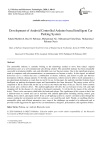
Development of Android Controlled Arduino based Intelligent Car Parking System
Статья научная
The automobile industry is currently looking at the technology needed to move from today's original autonomous autos to a self-contained and safe driving solution. The automobile industry has been remarkably successful in producing reliable, safe, and affordable cars over the past century. Due to the significant progress made in computers and telecommunications, an autonomous car became a reality. In this regard, an android driver-less car is a vehicle that uses a combination of motors, software, and sensors to park cars between destinations without a human operator. To be fully autonomous, vehicles must be able to travel unmanned to a pre-determined destination on roads that are not fit for use. In this paper, the android controlled Arduino based intelligent car parking development stages and functionalities has been discussed. The motor system will be composed of the dc motors that run the car as well as the wheels and body of the car. The DC motor controls the circuit and a software driver. The android application will drive the car forward, reverse, left, and right (stopping will be the absence of a forward or backward command). It will do this by means of the software driver. There is also one motor which holds the brake and release. The significance of this system is that it has a distinctiveness to control real cars in real-time with android applications including steering control, gear shifting, horn control, and engine on/off. It has a self-parking system in a narrow crowded system through the sensors reading the environment and with actuators, a car could be park itself. Finally, on enabling effective automobile safety and efficient automotive cars, some of the challenges are needed to be addressed (and to provide) useful suggestions for approval by car manufacturers, designers, policymakers, and regulatory bodies.
Бесплатно
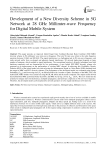
Статья научная
This paper presents an improved hybrid Equal Gain Combiner-Maximal Ratio Combiner (EGC-MRC) diversity scheme in 5G millimeter wave (mm-wave) frequency. The term 5G mm-wave refers to the radio frequency spectrum between 24 GHz and 100 GHz. The signal interference is a challenging task in 5G mm-wave frequency, and radio network suffer from co-channel and adjacent channel interference. 5G network deployment depends on large number of antennas, which resulted in signal interference. The conventional receiver’s diversity techniques have high hardware complexity and are characterized by low performance. A new hybrid EGC-MRC diversity scheme was proposed as an improvement on the performance of existing MRC scheme. In achieving this, Probability Density Function (PDF) of the hybrid model was derived using the instantaneous Signal-to- Noise Ratio (SNR) obtained from the output of MRC and EGC diversity schemes. The performance of the developed model was evaluated using Outage Probability 〖(P〗_out) and Processing time (P_t) at different SNR with L number of paths. Simulation of the MRC, EGC and hybrid EGC-MRC models were carried out using MATLAB 2018a and the results compared. The output results showed that hybrid EGC-MRC performed better than EGC and MRC by having a lower P_out and〖 P〗_t. This new model has the potential to mitigate network interference, multipath propagation, and hardware complexity in 5G mm-wave frequency. Therefore, the developed model can be deployed by network operators to solve signal interference in 5G network.
Бесплатно
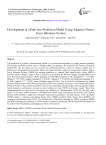
Development of a Path-loss Prediction Model Using Adaptive Neuro-fuzzy Inference System
Статья научная
The prediction of wireless communication signals is of paramount importance for proper network planning. The existing prediction models such as Okumura-Hata, Co-operative for Scientific and Technical Research (COST-231) and free space are less accurate for predicting path-loss values of wireless signals due to differences in propagation environments. Hence, this paper develops a path-loss model using Adaptive Neuro-Fuzzy Inference System (ANFIS) for accurate prediction of wireless High Speed Packet Access (HSPA) network signal in Ibadan, Nigeria. This is achieved by measuring the Received Signal Strength (RSS) from three Base Transmitting Stations (BTS) operating at 2100 MHz frequency in Ojo (longitude E 3’ 53.1060’, latitude N 7’27.2558’), Dugbe (longitude E 3’50.4361’, latitude N 7’ 23.0678’) and Challenge (longitude E 3’ 53.1060’, latitude N 7’ 21.258’) areas of Ibadan using the Drive Test. Ericson Test Equipment for Mobile System (TEMS) phone, Global Positioning System (GPS) and Computer System are used to obtain RSS data at different distances. Base station parameters such as the transmitting antenna height, receiving antenna height, carrier frequency and distance are used as input variables to train ANFIS to develop a model. These base station parameters are also used to investigate the suitability of Okumura-Hata, COST-231 and free space model. A five layer ANFIS structure is developed and trained using Least Square Error (LSE) and Gradient Descent (GD) method to adjust the consequent and premise parameters. The performance of the developed ANFIS model is evaluated using Mean Square Error (MSE) and Root Mean Square Error (RMSE) and compared with Okumura-Hata, COST 231 and free space. The results obtained for ANFIS give lower RMSE and MSE indicating the suitability of ANFIS model for path-loss prediction. The developed ANFIS model can be used for network planning and budgeting in these environments.
Бесплатно
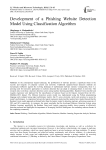
Development of a Phishing Website Detection Model Using Classification Algorithm
Статья научная
In the contemporary digital landscape, the proliferation of malware presents a significant threat to the security and integrity of computer systems and networks. Traditional signature-based detection methods are increasingly ineffective against the evolving landscape of sophisticated malware variants. Consequently, there is a pressing need for innovative approaches to malware detection that can adapt to emerging threats in real-time. This research aims to develop a malware detection system using machine learning algorithms. Random Forest classifier and Logistic regression were deployed for the classification of malware based on the features extracted from the CIC-MalMem-2022 dataset. The Malware detection system model was implemented using the Python programming language and evaluated using major performance metrics like F1-score, precision, recall, and accuracy to assess the model’s performance. A comparison between the logistic regression model and the random forest model showed that the Random Forest model approach performed better than the logistic model in detecting malware, achieving accuracies of 98% and 94% respectively. In summary, the report concludes that the developed Malware Detection System using Machine Learning, specifically the Random Forest and Logistic regression models, shows promise in effectively detecting malware and highlights the importance of leveraging Artificial Intelligence for combating malware threats in the computing community.
Бесплатно
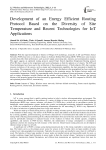
Статья научная
With the rapid development of Internet of Things (IoT) technology, researches in IoT and Wireless Sensor Networks (WSNs) has led to a very heavy reliance on Software Defined Networking (SDN). WSNs have some resource scarcities that affect their performance, such as power supply, processing units, memory, and communication capacity. This paper suggests an optimized routing protocol, named Future Search Algorithm-Temperature Routing protocol (FSA-TR) that is based on the temperature and recent technologies to find the optimal set of clusters. The SDN and Cloud technologies have been used in the architecture of the proposed protocol. A Multi-objective FSA that considers resource restrictions of the sensors, such as energy and communication capability, has been presented to identify the best solution. The temperature of the IoT sensors according to their distribution in the geographical has been considered. Accordingly, a Cluster Head (CH) is selected depending on the remaining energy, the distance between nodes, and environmental temperature. Finally, the experimental results showed an enhanced system performance of many features, such as energy dissipation, network lifetime and the number of packets sent to the sink. For instance, the network lifetime of the proposed protocol has been increased by approximately 36%, 27% and 20% compared to LEACH, SEP and optimized protocol PSO-C, consecutively.
Бесплатно
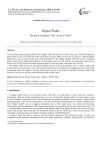
Статья научная
As the world is getting digital there are few things which are used as it is for a long time. The most important thing which we do in our daily life is the transaction of money. Money transaction is a process which should be digitized for more security and the ease of the individual. So, by making a digital wallet the money transaction can be made much simpler and effortless. Using digital wallet we can keep all our important cards such as health card, driving license and other important papers in only one place with much more security. The digital wallet can be our transaction medium which can be used anywhere such as shops, malls or for giving money to someone else. And with such high security such as finger print scanning our money and all the information which the wallet is carrying will be safe. In case, if the wallet is lost GPS will help to detect the location of our device and that what makes the wallet a digital safe.
Бесплатно
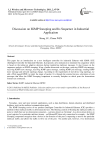
Discussion on IGMP Snooping and Its Sequence in Industrial Applicaiton
Статья научная
This paper has an introduction on a new intelligent controller for industrial Ethernet with IGMP: ICIE (Intelligent Controller for Industrial Ethernet). It proposed a new mechanism to minimize the congestion which is based on the taking an adaptive decision during transferring multicast messages. It also focuses on the sequences analysis on IGMP snooping. It has a further discussion on the steps: receiving IGMP loin message, receiving IGMP leave message, receiving IGMP query message, sending IGMP join message, sending IGMP leave message and network topology change. According to the requirement of end device ring topology, we add a DSA tagged BPDU to indict the target of packet. It is through the external devices solicitation of join messages that allow the IGMP Snooping component to correctly decipher on which ports the downstream listeners are connected.
Бесплатно
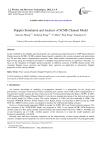
Doppler Simulation and Analysis of SCME Channel Model
Статья научная
In this contribution, the Doppler spectral properties are simulated and analyzed based on 3GPP Spatial Channel Model extension (SCME). SCME standard channel model is applied to the system evaluation and optimization in LTE and other future communication networks. Since future mobile communication systems demand for high moving speed, the simulation and analysis of Doppler characteristics become so significant. Therefore, we focus on the simulation of Doppler spectral properties in different scenarios of SCME channel model. The simulated Doppler power spectrum and Doppler delay spectrum are applicable to characterize Doppler properties of time-varying channels.
Бесплатно
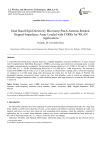
Статья научная
A suspended dual band planar antenna based on a stepped-impedance structure modified to an array, loaded with Complementary Split-Ring Resonators (CSRRs), possessing good directivity pertaining point to point backhaul communication is acquainted. The presented antenna radiates at 2.4-2.5 GHz (4.4%) and 5.3-5.9 GHz (12%) with |S11| < −10 dB, accompanying directivity of 11.6 dBi and 11.3 dBi respectively. The antenna is loaded with CSRRs which works as a L-C tank resonator, to obtain better coupling, and to lower the frequency of radiation in 2.4 GHz band along with decreasing the return loss for both the bands of WLAN. The Suspended antenna, symmetrical across vertical axis, has four branches, each of which are obtained from Maximally Stepped-Impedance filter. A stable radiation pattern with high directivity in both the WLAN bands is achieved.
Бесплатно
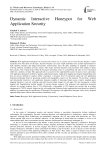
Dynamic Interactive Honeypot for Web Application Security
Статья научная
Web application honeypots are security tools used to act as a decoy server. Over the past decades, various researches have been done on the topic. Security breaches can cause simple individual user account impersonation to bank database breaches and illegal transactions. Cybersecurity faces the daily challenge of adapting to attackers' evolving methods, including zero-day attacks. This makes intrusion detection and prevention tools unable to detect these attacks. The existing trend within the honeypot technology relies on a predefined and static level of interaction either low, medium, or high. This approach fails to account for the unpredictable nature of attack vectors and makes web application honeypots ineffective against sophisticated attacks. Application logging and request fingerprinting also have no proven methods to employ within a honeypot. A dynamic level of interaction makes the web application honeypot technology better by presenting scalable and manageable control over the attackers. We develop a modular and dynamically interactive web application honeypot capable of detecting broken access control, standard query language injection, cross-site scripting, and path traversal attack targets for web apps. We also incorporate a robust logging and fingerprinting module capable of tracing attacker requests. The proposed web application honeypot achieves an average response time of 523 milliseconds, a throughput of 105 requests per second, and an average engagement of 769.38 seconds. Improving the web application Honeypot helps organizations keep themselves ahead of attackers by empowering the significance of Honeypot. Developing a web application honeypot with a newly designed approach helps other scholars and researchers extend their work.
Бесплатно
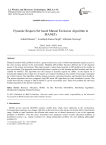
Dynamic Request Set based Mutual Exclusion Algorithm in MANETs
Статья научная
Mutual Exclusion (ME) problem involves a group of processes, each of which intermittently requires access to the only resource present in the environment. Handling ME problem becomes difficult due to the dynamic nature of the ad hoc environment. This paper presents a token-based solution to ME problem in the mobile ad hoc environment. The proposed token based algorithm is sensitive to link forming and link breaking and thus is suitable for MANET. The algorithm uses the concept of dynamic request set (DRS). As the request set is dynamically updated, the average size of request set is reduced resulting in less number of messages exchanged per critical section. The algorithm satisfies mutual exclusion, starvation freedom, and freedom from deadlock. The present algorithm has been compared with DRS based ME algorithms for static distributed systems. The results show that the concept of DRS in MANETs can be successfully used. Token loss problem has also been handled separately in the present exposition.
Бесплатно
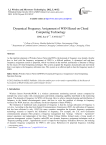
Dynamical Frequency Assignment of WSN Based on Cloud Computing Technology
Статья научная
As the rapid development of Wireless Sensor Networks(WSN), the demands of frequency rose sharply, thereby how to deal with the frequency assignment of WSN is a difficult problem. A dynamical and real-time frequency assignment system is proposed, which was based on the network architecture of Internet of Things by the means of Cloud Computing technique. The system assigned the frequency dynamically and real-timely that it can improve the frequency utilization rate. This system is an efficient path to face the frequency needs of WSN.
Бесплатно
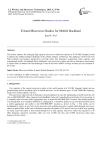
E-band Microwave Radios for Mobile Backhaul
Статья научная
This article explores the emerging high capacity microwave radios that operate in 70-90 GHz frequency band to address the mobile backhaul challenge of the cellular industry of Pakistan. The challenge will be look from both technical and business perspectives covering topics like frequency assignments, radio capacity, and experimental results. In hindsight these millimeter wave microwave radios provide an alternative (particularly to optical fiber) to address the said challenge of one of the lowest ARPU (average revenue per user) markets of the world.
Бесплатно
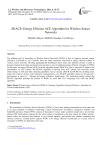
EEACE: Energy Efficient ACE Algorithm for Wireless Sensor Networks
Статья научная
The ultimate goal of researches on Wireless Sensor Networks (WSNs) is how to improve network energy efficiency as possible as can. Certainly, there are many researches concerned to energy efficient scheme in wireless sensor networks. Dividing geographically distributed sensor nodes into different clusters in order to decrease transmission range and transmission quantity is one of traditional energy efficient strategies for WSNs. In this paper, an energy efficient ACE clustering algorithm named EEACE in short is presented to improve the performance of ACE scheme. The EEACE algorithm is derived from ACE scheme but overcomes many shortcomings of ACE and other clustering algorithms such as famous LEACH and DCHS. By dividing sensor nodes into uniform clusters with minimum communication cost, EEACE algorithm improves the network’s performance at aspect of lifetime and energy efficiency significantly. The simulation results verified that EEACE algorithm prolongs the lifetime of WSNs by more than 15% comparing with ACE and DCHS algorithm.
Бесплатно

Статья научная
As most of the wireless sensor networks are unattended by humans, the energy is an important issue while deploying nodes of wireless sensor network in hazardous environments. One of the method to preserve energy consumption among sensor nodes is clustering. Using clustering, the nodes send the data to the nearest cluster head instead of far away sink. In applications using reactive wireless sensor networks, a limited number of sensor nodes are activated due to exceed in threshold values and the other nodes are under idle state. As far as the reactive wireless sensor network is concerned, the number of clusters would have been based on the number of active nodes and alive nodes. In this work, an optimum number of clusters is computed based on the ratio between active nodes and alive nodes. Extensive analysis and comparisons are made with existing protocol and found that the proposed methodology outperforms the existing protocol in terms of networks life time and throughput.
Бесплатно
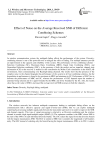
Effect of Noise on the Average Received SNR of Different Combining Schemes
Статья научная
In wireless communication system, the multipath fading affects the performance of the system. Diversity-combining scheme is one of the powerful tools to mitigate the effect of fading. The multiple antennas provide an improvement in the capacity and reliability of the system. The performance of four combining schemes - Selection Combining (SC), Maximum Ratio Combining (MRC), Equal Gain Combining (EGC), and Generalised Selection combining (GSC)- in the presence of both the perfect and an imperfect channel state information (CSI) at the receiver is studied in this contribution by Monte Carlo simulations in the MATLAB environment, when communicating over Rayleigh fading channels. Our results show that the presence of the complex noise in the channel degrades the performance of the system in all four combining schemes, but the degradation in performance is found to be maximum in MRC and minimum in SC. Performance of EGC lies in between the performance of MRC and SC, whereas the performance of GSC depends upon the number of antennas being selected and it is upper bounded by the MRC and lower bounded by the SC. Also, the results show that as the value of SNR is increased the average received SNR increases in both the channels.
Бесплатно
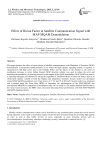
Effect of Rician Factor in Satellite Communication Signal with MAP-MQAM Demodulation
Статья научная
This paper presents the effect of rician factors in satellite communications with Maximum A Posteriori (MAP) demodulation. Conventional QAM presently in use where the high capacity signaling scheme is required, is characterized with high errors due to the Doppler Effect and the nature of the channel as the order of modulation increases in rician fading channel. MAP detection scheme was used to reduce the error and maximize the probability of choosing correctly at the output of the QAM demodulator. MAP QAM was used as a signaling technique and obtained by taking the logarithm of Likelihood Ratio of observed binary data of an observation random variable at both the Inphase and Quadrature channels. System model was developed around MAP-QAM demodulator over rician factors of 5, 10, and 15 at 90 km/h. System model was simulated and evaluated using Bit Error Rate (BER) to determine the performances of the MAP-MQAM and conventional MQAM for comparison at modulation order 'M' of 4 and 16. The results obtained showed that as the rician factor increases, the BER values decreased indicating better performance with both MAP-MQAM and QAM signaling scheme.
Бесплатно
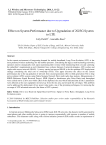
Effect on System Performance due to Upgradation of 2G/3G System to LTE
Статья научная
In the current environment of burgeoning demand for mobile broadband, Long Term Evolution (LTE) is the most preferred wireless technology for the mobile operators. Considering the legacy multi-technology networks, operators need to strategically work upon maximizing their revenue while minimizing their cost and satisfying the subscriber's requirements as well. Operators have a choice between 2 network strategies- LTE overlay and single radio access network (SRAN). A survey carried out proved SRAN to be the optimum LTE deployment strategy considering the total cost of ownership (TCO). This paper discusses the effect on the system performance due to the up gradation of network from second generation (2G) to third generation (3G) to long term evolution (LTE) systems using Nokia Siemens Network Flexi multi-radio base stations. Measurements of RSRP (Reference Signal Received Power), SINR (Signal to Interference plus Noise Ratio) and throughput were carried out by a drive test within 2Km of the deployed site area which indicated that all the 3 parameters were affected as the user equipment moved away from the site area and towards the cell edges. This problem can be addressed by deployment of low power relay nodes, one of the promising techniques, for increasing the coverage of LTE advanced networks (the future of LTE systems).
Бесплатно
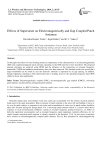
Effects of Superstrate on Electromagnetically and Gap Coupled Patch Antennas
Статья научная
In this paper the effects of water loading (termed as superstrate) on the characteristics of an electromagnetically (EM) and coupled pentagonal patch antennas operating in the ISM band have been described. The proposed antenna structures are analyzed using HFSS and the influence of the superstrate on resonant frequency, bandwidth, VSWR and radiation characteristics have also been analyzed. The obtained results also reveal that a larger bandwidth can be found in case the dielectric substrate is separated by air gap spacing. In addition, though impedance matching is little deteriorated due to loading, however the operating frequency band (BW) shifted to lower side significantly.
Бесплатно
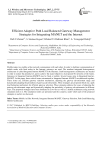
Статья научная
Mobile nodes in a mobile ad hoc network communicate with each other. In order to facilitate communication of mobile nodes with fixed nodes in the Internet, gateways are used. The resultant integrated heterogeneous architecture is called Integrated Internet MANET in the literature. Such heterogeneous architectures are needed in order to realize the potential of, and to achieve the stated objectives of proposed 5G networks of the future. Gateways in Integrated Internet-MANET may be fixed or mobile. Several issues arise in Integrated Internet-MANET. In this paper, three critical issues encountered in Integrated Internet-MANET are addressed together. These issues are, efficient gateway selection mechanism, adjusting the gateway advertisement range and dynamically adapting the periodicity of gateway advertisements. Three strategies are proposed which use a path load balancing mechanism for efficient gateway selection. These strategies address the issues of adjusting the gateway advertisement range and dynamically adapting the periodicity of gateway advertisements in different ways. The proposed strategies have been simulated in a two-tier as well as a hybrid architecture using network simulation tool ns-2. The simulation results are presented and the scenarios, under which each of the proposed strategies is useful, are discussed.
Бесплатно

